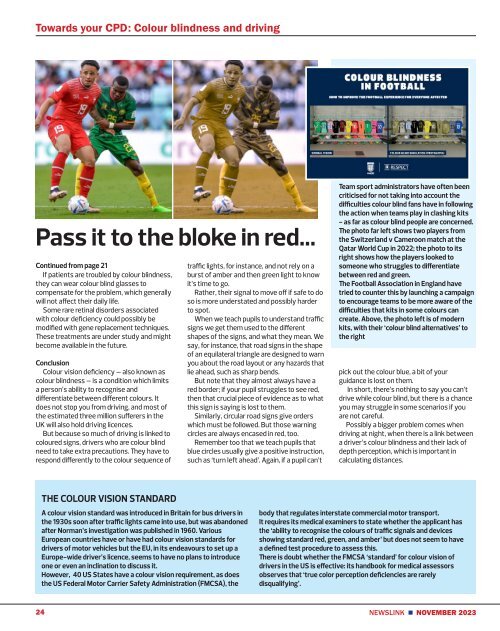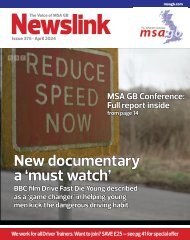Newslink November
Motor Schools Association of Great Britain members magazine; driver training and testing; road safety; general motoring
Motor Schools Association of Great Britain members magazine; driver training and testing; road safety; general motoring
You also want an ePaper? Increase the reach of your titles
YUMPU automatically turns print PDFs into web optimized ePapers that Google loves.
Towards your CPD: Colour blindness and driving<br />
Pass it to the bloke in red...<br />
Continued from page 21<br />
If patients are troubled by colour blindness,<br />
they can wear colour blind glasses to<br />
compensate for the problem, which generally<br />
will not affect their daily life.<br />
Some rare retinal disorders associated<br />
with colour deficiency could possibly be<br />
modified with gene replacement techniques.<br />
These treatments are under study and might<br />
become available in the future.<br />
Conclusion<br />
Colour vision deficiency – also known as<br />
colour blindness – is a condition which limits<br />
a person’s ability to recognise and<br />
differentiate between different colours. It<br />
does not stop you from driving, and most of<br />
the estimated three million sufferers in the<br />
UK will also hold driving licences.<br />
But because so much of driving is linked to<br />
coloured signs, drivers who are colour blind<br />
need to take extra precautions. They have to<br />
respond differently to the colour sequence of<br />
traffic lights, for instance, and not rely on a<br />
burst of amber and then green light to know<br />
it’s time to go.<br />
Rather, their signal to move off if safe to do<br />
so is more understated and possibly harder<br />
to spot.<br />
When we teach pupils to understand traffic<br />
signs we get them used to the different<br />
shapes of the signs, and what they mean. We<br />
say, for instance, that road signs in the shape<br />
of an equilateral triangle are designed to warn<br />
you about the road layout or any hazards that<br />
lie ahead, such as sharp bends.<br />
But note that they almost always have a<br />
red border; if your pupil struggles to see red,<br />
then that crucial piece of evidence as to what<br />
this sign is saying is lost to them.<br />
Similarly, circular road signs give orders<br />
which must be followed. But those warning<br />
circles are always encased in red, too.<br />
Remember too that we teach pupils that<br />
blue circles usually give a positive instruction,<br />
such as ‘turn left ahead’. Again, if a pupil can’t<br />
Team sport administrators have often been<br />
criticised for not taking into account the<br />
difficulties colour blind fans have in following<br />
the action when teams play in clashing kits<br />
- as far as colour blind people are concerned.<br />
The photo far left shows two players from<br />
the Switzerland v Cameroon match at the<br />
Qatar World Cup in 2022; the photo to its<br />
right shows how the players looked to<br />
someone who struggles to differentiate<br />
between red and green.<br />
The Football Association in England have<br />
tried to counter this by launching a campaign<br />
to encourage teams to be more aware of the<br />
difficulties that kits in some colours can<br />
create. Above, the photo left is of modern<br />
kits, with their ‘colour blind alternatives’ to<br />
the right<br />
pick out the colour blue, a bit of your<br />
guidance is lost on them.<br />
In short, there’s nothing to say you can’t<br />
drive while colour blind, but there is a chance<br />
you may struggle in some scenarios if you<br />
are not careful.<br />
Possibly a bigger problem comes when<br />
driving at night, when there is a link between<br />
a driver’s colour blindness and their lack of<br />
depth perception, which is important in<br />
calculating distances.<br />
THE COLOUR VISION STANDARD<br />
A colour vision standard was introduced in Britain for bus drivers in<br />
the 1930s soon after traffic lights came into use, but was abandoned<br />
after Norman’s investigation was published in 1960. Various<br />
European countries have or have had colour vision standards for<br />
drivers of motor vehicles but the EU, in its endeavours to set up a<br />
Europe-wide driver’s licence, seems to have no plans to introduce<br />
one or even an inclination to discuss it.<br />
However, 40 US States have a colour vision requirement, as does<br />
the US Federal Motor Carrier Safety Administration (FMCSA), the<br />
body that regulates interstate commercial motor transport.<br />
It requires its medical examiners to state whether the applicant has<br />
the ‘ability to recognise the colours of traffic signals and devices<br />
showing standard red, green, and amber’ but does not seem to have<br />
a defined test procedure to assess this.<br />
There is doubt whether the FMCSA ‘standard’ for colour vision of<br />
drivers in the US is effective: its handbook for medical assessors<br />
observes that ‘true color perception deficiencies are rarely<br />
disqualifying’.<br />
24 NEWSLINK n NOVEMBER 2023
















